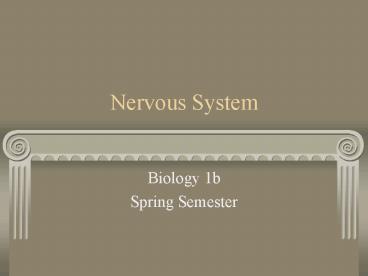Nervous System PowerPoint PPT Presentation
1 / 46
Title: Nervous System
1
Nervous System
- Biology 1b
- Spring Semester
2
Outline of nervous system unit
- Evolution of nervous system
- Basics of the vertebrate nervous system
- How an action potential is transmitted
- Organization of nervous system
- Brain structure function
- Special senses
3
Evolution of nervous system
4
Sponges-Phylum Porifera
- Do not have a nervous system that allows them to
respond to change in the environment
http//www.datacomm.ch/renebu/los_roques/los_roque
s.html
5
Cnidarians
- Sea jellies
- Neurons form diffuse network nerve net
http//www.world-builders.org/planets2000/Gump/Lim
on/AQAnimal3/Cnidar.html
6
Flatworms Phylum Platyhelminthes
- More specialized than the cnidarians
- Increased coordination, for increased motility
- 2 lateral nerve cords nerve ladder with 2
ganglia at anterior end
publish.uwo.ca/jkiernan/ anfound.htm
7
Round worm- Phylum Nematoda
- Simple nervous system, have several ganglia, have
simple sense organs to detect chemical given off
by prey or host
http//www.janssenpharmaceutica.be/jah/images/foto
srechts/dogs3.jpg
8
Segmented worms-Phylum Annelida
- Earthworm
- Double ventral nerve cord
- 2 cords meet as ganglia for each segment of the
body
http//cas.bellarmine.edu/tietjen/images/annelids.
htm
9
Mollusks-Phylum Mollusca
- Clams, snails, squid
- Nervous system varies in this phylum with the
activity of the organism. Octopi are capable of
complex behavior, therefore complex nervous
system. - 3 pair of ganglia of equal size 1)cerebral
2)visceral 3)pedal
http//www.blazemonger.com/GG/albums/octopus.html
10
Phylum Echinodermata
- Sea stars
- Nerve ring around mouth
www.usfca.edu/fac-staff/chienp/
phylum20echinodermata.html
http//www.biology.ucsc.edu/classes/bio136/echinod
ermata/asteroidea/asteroidea.html
11
Arthropods- Phylum Arthropoda
- Insects, crustaceans, spiders etc.
- Well developed nervous systems, with a brain,
dorsal nerve cord, sophisticated sense organs
http//lamar.colostate.edu/insects/systems/nervou
s/nervous.html
12
Vertebrates- Phylum Chordata
- Increased cephalization
- Dorsal nervous system
http//www.uoguelph.ca/zoology/devobio/210labs/ect
o3.html
13
Basics of the vertebrate nervous system
14
Basic unit nerve cellNeuronGroup of neuron
ganglia
15
Types of neurons
- Motor neuron- (efferent neuron)-
- Transmits away form CNS
- Sensory neuron (afferent neuron)-
- Transmits to CNA
- Interneuron (association neuron)-
- Inside of CNS, connects neurons
16
Reflex arc
http//web.ukonline.co.uk/webwise/spinneret/humans
/recodr.htm
17
(No Transcript)
18
Synapse-gap between neurons
http//images.google.com/images?hlenlrieUTF-8
oeUTF-8qsynapse
19
2. 3. 4. 5. 6.
20
- Resting state
- Depolarization
- A nerve cell is stimulated.
- permeable to Na for an instant and they quickly
move into the cell. - inner surface is positive
- Repolarization
- When the cell membrane becomes depolarized, K
automatically leave the cell until the cell is
back to its resting state. - The impulse travels
- Transmission across a synapse
- Refractory period
- A neuron cannot be stimulated during this period.
This period of time is about 0.0004 of a second.
21
Movement of an impulse
22
Movement of an impulse
23
Movement of an impulse
24
http//www.accessexcellence.org/AB/GG/Fig_12.33.jp
g
25
Organization of nervous system
26
http//www.futuredynamicadvantage.com/research/reg
enerative_neurosciences.html
27
CNS structure function
http//serendip.brynmawr.edu/bb/kinser/Home1.html
28
The Brain
http//www.dartmouth.edu/artsci/ethics-inst/videos
.html
- Ultimate example of cephalization
- Important so it is covered be the skull, layers
of protective tissue called meninges, and
cerebral spinal fluid (CSF)
29
http//training.seer.cancer.gov/module_anatomy/uni
t5_3_nerve_org1_cns.html
30
cerebrum
- Two parts
- Cerebral cortex- gray matter
- Cerebral medulla white matter-covered with
myelin
http//www.riken.go.jp/lab-www/frontier-div/PAMPHL
ET/KENKYUJOHO/p33/ep33.html
31
Cerebrum- four lobes
http//serendip.brynmawr.edu/bb/kinser/Home1.html
32
Cerebrum- four lobesfrontal
- Frontal Lobe- associated with reasoning,
planning, parts of speech, movement (motor
control), emotions, and problem solving
http//www.cyberpunks.org/freeside/mab_neuro2.html
33
Cerebrum- parietal lobe
- Parietal Lobe- associated with movement,
orientation, recognition, perception of stimuli
sensory input
http//www.benbest.com/science/anatmind/anatmd6.ht
ml
http//www.alzheimer-montpellier.org/apraxies.html
34
Cerebrum- occipital
- Occipital Lobe- associated with visual processing
http//medlib.med.utah.edu/kw/sol/sss/subj2.html
35
Cerebrum- temporal
- Temporal Lobe- associated with perception and
recognition of auditory stimuli, memory, and
speech
http//www.howe.k12.ok.us/jimaskew/bnerves.htm
36
http//www.macalester.edu/psych/whathap/UBNRP/Spl
it_Brain/Corpus20Callosum.html
37
Cerebellum-second biggest structure on brain
- Controls muscle coordination and balance "learn"
and store motor patterns.
http//www.on-with-life.org/WebFrames/Cerebellum.h
tm
38
Thalamus Hypothalamusfound between brain stem
cerebrum
- Thalamus- receives messages from the sense
organs, relays that info to the correct part of
the cerebrum - Hypothalamus- control center for recognition and
analysis of hunger, thirst, fatigue, anger, and
body temperature. (maintain homeostasis)
39
Brainstem (midbrain, pons, medulla oblongata)
- Mid brain- hearing and balance
- Pons- involved in the control of breathing
- Medulla oblongata- regulate visceral activity
(heart rate, blood pressure, breathing,
swallowing, vomiting)
http//training.seer.cancer.gov/module_anatomy/uni
t5_3_nerve_org1_cns.html
40
Spinal cord
http//www.spinal-cord-injury-resources.com/spinal
-important.html
http//www.bowdoin.edu/jkinsman/PAGES20121201/ve
ntralhornmotorneurons.html
41
Special senses
42
Eyevision stimuli is processed in occipital lobe
http//whyfiles.org/shorties/098dog_genetherapy/
43
Ear-auditory stimuli is processed in parietal lobe
http//pcbunn.cacr.caltech.edu/Cochlea/
http//liftoff.msfc.nasa.gov/news/2002/news-mixup.
asp
44
(No Transcript)
45
Touch- sense receptor through out your body,
integrated in parietal lobe
http//www.anatomy-resources.com/human-anatomy/sh2
83.htm
46
Taste
http//www.udel.edu/Biology/Wags/histopage/colorpa
ge/co/co.htm

